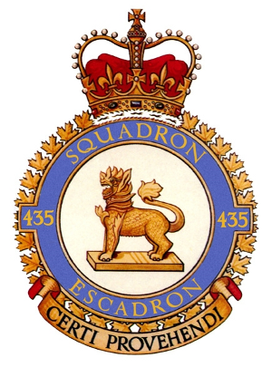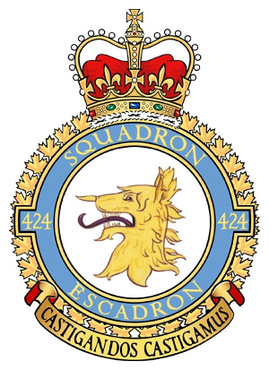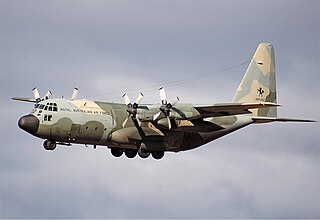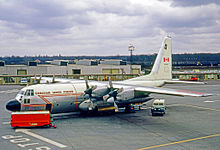The history of the Royal Canadian Air Force begins in 1914, with the formation of the Canadian Aviation Corps (CAC) that was attached to the Canadian Expeditionary Force during the First World War. It consisted of one aircraft that was never called into service. In 1918, a wing of two Canadian squadrons called the Canadian Air Force (CAF) was formed in England and attached to the Royal Air Force, but it also would never see wartime service. Postwar, an air militia also known as the Canadian Air Force was formed in Canada in 1920. In 1924 the CAF was renamed the Royal Canadian Air Force (RCAF) when it was granted the royal title by King George V. The RCAF existed as an independent service until 1968.

The Royal Canadian Air Force is the air and space force of Canada. Its role is to "provide the Canadian Forces with relevant, responsive and effective airpower". The RCAF is one of three environmental commands within the unified Canadian Armed Forces. As of 2020, the Royal Canadian Air Force consists of 12,074 Regular Force and 1,969 Primary Reserve personnel, supported by 1,518 civilians, and operates 258 manned aircraft and nine unmanned aerial vehicles. Lieutenant-General Eric Kenny is the current Commander of the Royal Canadian Air Force and Chief of the Air Force Staff.

No. 47 Squadron is an inactive squadron of the Royal Air Force. Formed in 1916, it saw service during the First World War in the UK and in Greece. Between the wars it served in Egypt and Sudan, and at the outbreak of the Second World war undertook bombing operations against Italian positions in Eritrea. Later it was based in Libya and Tunisia, taking part in anti-shipping operations in the Mediterranean. In 1944 the squadron moved to India, and began operations against the Japanese in Burma and elsewhere.

Canadian Forces Base Trenton, formerly RCAF Station Trenton, is a Canadian Forces base located within the city of Quinte West, Ontario. It is operated as an air force base by the Royal Canadian Air Force (RCAF) and is the hub for air transport operations in Canada and abroad. Its primary RCAF lodger unit is 8 Wing, commonly referred to as 8 Wing Trenton. CFB Trenton is Canada's largest Air Force base and most southerly air base.

408 Tactical Helicopter Squadron is a unit of 1 Wing, Kingston. It is co-located with 1 Canadian Mechanized Brigade Group at Canadian Forces Base (CFB) Edmonton.

437 Transport Squadron is a unit of the Canadian Armed Forces under the Royal Canadian Air Force, based at CFB Trenton in Ontario. The unit operates the CC-150 Polaris, the CC-330 Husky, and is responsible for long range military and VIP transportation.

413 Transport and Rescue Squadron is an air force squadron of the Canadian Armed Forces. It was originally a flying boat squadron of the Royal Canadian Air Force during the Second World War. It currently operates the C-130 Hercules and the CH-149 Cormorant in transport plus search and rescue roles at CFB Greenwood.

The 36th Airlift Squadron is an airlift squadron of the United States Air Force. It is part of the 374th Operations Group at Yokota Air Base, Japan.

No. 428 Squadron RCAF, also known as 428 Bomber Squadron, and 428 Ghost Squadron, was first a night bomber squadron of the Royal Canadian Air Force engaged in strategic bombing during World War II, based in Yorkshire. At the end of the war the squadron moved to Nova Scotia before being disbanded in September 1945. In 1954 the squadron was reformed as 428 All-Weather (Fighter) Squadron, before being again disbanded in 1961.

426 Transport Training Squadron is a unit of the Canadian Forces under Royal Canadian Air Force, located at CFB Trenton in Trenton, Ontario. It originated as a squadron in the Royal Canadian Air Force (RCAF) that fought during the Second World War as a bomber squadron.
Air Transport Command (ATC) was a command of the Canadian Forces created in 1968 upon unification and eliminated in 1975.

The Lockheed Martin C-130J Super Hercules is an American four-engine turboprop military transport aircraft. The C-130J is a comprehensive update of the Lockheed C-130 Hercules, with new engines, flight deck, and other systems.

The 143rd Airlift Squadron is a unit of the 143rd Airlift Wing, Rhode Island Air National Guard located at Quonset Point Air National Guard Station, Rhode Island. The 143rd is equipped with the Lockheed Martin C-130J Super Hercules.

435 Transport and Rescue Squadron, nicknamed "Chinthe Squadron", is a Royal Canadian Air Force strategic transport, aerial refuelling and search and rescue unit based at Canadian Forces Base (CFB) Winnipeg in the province of Manitoba, Canada. The squadron flies four Lockheed CC-130H Hercules aircraft. In addition to being the only provider of tactical fighter air-to-air refuelling in Canada, the squadron is a provider of primary search and rescue response for the largest search and rescue region in Canada, controlled from CFB Trenton. The squadron keeps an aircraft on constant readiness to deploy, with airborne search and rescue technicians standing by to respond within 30 minutes of notification during weekdays and 2 hours at other times. The Trenton Search and Rescue Region, also covered by the 424 Transport and Rescue Squadron, extends from Quebec City to the Rocky Mountains, and from the Canada–United States border to the North Pole, covering most of Central, Western, and Northern Canada.

424 Transport and Rescue Squadron, nicknamed "Tiger Squadron", is a Royal Canadian Air Force strategic transport and search and rescue unit based at Canadian Forces Base (CFB) Trenton in the Canadian province of Ontario. The squadron is the primary provider of search and rescue response for the Trenton Search and Rescue Region, which extends from Quebec City to the Rocky Mountains, and from the Canada–United States border to the North Pole, covering an area of over ten million square kilometres in Central, Western, and Northern Canada.

429 Transport Squadron of the Royal Canadian Air Force is one of four squadrons attached to CFB Trenton in Trenton, Ontario. The squadron was originally formed as a bomber squadron of the Royal Canadian Air Force (RCAF) attached to RAF Bomber Command during the Second World War.

440 Transport Squadron is a unit of the Canadian Armed Forces under the Royal Canadian Air Force. It is part of 8 Wing and works closely with Joint Task Force (North) in Yellowknife, Northwest Territories.

Operation Mobile was the name given to Canadian Forces activities in the 2011 military intervention in Libya. The United States' counterpart to this was Operation Odyssey Dawn, the French counterpart was Opération Harmattan and the British counterpart was Operation Ellamy. The no-fly zone was proposed during the Libyan Civil War to prevent government forces loyal to Muammar Gaddafi from carrying out air attacks on anti-Gaddafi forces and civilians. The demonstrations in Libya were part of the larger Arab Spring movement that began in the country of Tunisia on 18 December 2010. When demonstrations began in Libya, the government of Muammar Gaddafi responded with systematic attacks by air and ground forces, and repression of the protesters. In a speech, Gaddafi promised to chase down the protesters and cleanse the country "house by house". Several countries prepared to take immediate military action at a conference in Paris on 19 March.

The Royal Australian Air Force (RAAF) has operated forty-eight Lockheed C-130 Hercules transport aircraft. The type entered Australian service in December 1958, when No. 36 Squadron accepted the first of twelve C-130As, replacing its venerable Douglas C-47 Dakotas. The acquisition made Australia the first operator of the Hercules after the United States. In 1966 the C-130As were joined by twelve C-130Es, which equipped No. 37 Squadron. The C-130As were replaced by twelve C-130Hs in 1978, and the C-130Es by twelve C-130J Super Hercules in 1999. No. 37 Squadron became the RAAF's sole Hercules operator in 2006, when No. 36 Squadron transferred its C-130Hs before converting to Boeing C-17 Globemaster III heavy transports. The C-130Hs were retired in November 2012, leaving the C-130J as the only model in Australian service. A further twenty C-130Js will be ordered to replace the current fleet.



















